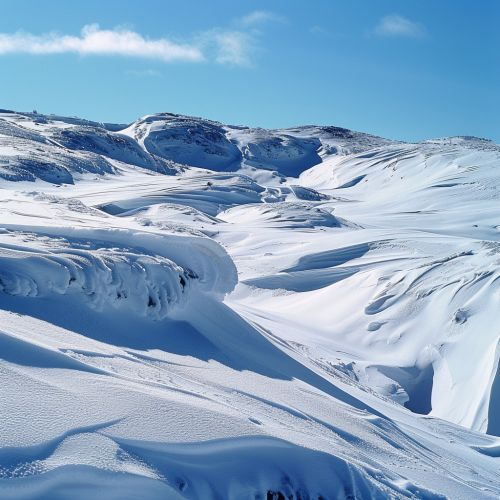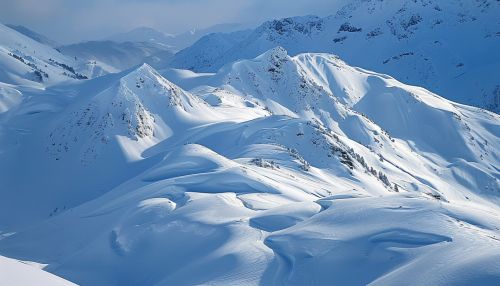Névé
Introduction
Névé, also known as firn, is a granular type of snow that has been partially melted, refrozen, and compacted. This process is a critical stage in the formation of glacial ice. Névé is typically found in the accumulation zone of glaciers, where snowfall accumulates and persists through the summer months. The transformation from snow to névé and eventually to glacial ice involves complex physical and chemical processes that are essential for understanding glaciology and climate science.
Formation of Névé
The formation of névé begins with the accumulation of snowflakes, which are initially light and fluffy. Over time, the weight of additional snowfall compresses the underlying layers, causing the snowflakes to break apart and recrystallize into more compact grains. This process is known as sintering. The transformation from fresh snow to névé can take several months to years, depending on the local climate conditions, including temperature and precipitation rates.


Sintering Process
Sintering is a key process in the formation of névé. It involves the bonding of snow grains at their contact points, which reduces the porosity and increases the density of the snowpack. The sintering process is driven by temperature gradients within the snowpack, causing water vapor to migrate from warmer to cooler areas, where it condenses and refreezes. This results in the growth of ice crystals and the reduction of pore spaces.
Metamorphism
Metamorphism in the context of snow and ice refers to the changes in the structure and properties of snow grains due to temperature fluctuations and mechanical stress. There are two main types of metamorphism: destructive and constructive. Destructive metamorphism occurs when temperature gradients cause the sublimation of ice at grain boundaries, leading to a rounding of snow grains. Constructive metamorphism, on the other hand, involves the deposition of water vapor onto ice crystals, causing them to grow larger and more angular. Both types of metamorphism contribute to the densification of snow into névé.
Characteristics of Névé
Névé has distinct physical and chemical properties that differentiate it from both fresh snow and glacial ice. It is typically denser than fresh snow, with a density ranging from 0.4 to 0.8 grams per cubic centimeter. The grain size of névé is also larger, often ranging from 0.5 to 2 millimeters. Chemically, névé can contain impurities such as dust, volcanic ash, and pollutants, which can affect its albedo and melting behavior.
Density and Porosity
The density of névé increases over time as it undergoes further compaction and recrystallization. The initial porosity of fresh snow, which can be as high as 90%, decreases significantly as the snow transforms into névé. This reduction in porosity is crucial for the eventual formation of glacial ice, which has a much lower porosity and higher density.
Grain Size and Shape
The grain size of névé is an important parameter that influences its mechanical properties and behavior under stress. Larger grain sizes typically result from prolonged metamorphism and the presence of liquid water, which facilitates the growth of ice crystals. The shape of névé grains can vary from rounded to angular, depending on the dominant metamorphic processes.
Role in Glacial Formation
Névé plays a pivotal role in the formation and dynamics of glaciers. It serves as the intermediate stage between fresh snow and glacial ice, providing the necessary material for glacier growth. The accumulation and compaction of névé in the accumulation zone of a glacier contribute to the glacier's mass balance and overall health.
Accumulation Zone
The accumulation zone of a glacier is the area where snowfall exceeds melting and sublimation, leading to a net gain in ice mass. In this zone, névé accumulates and undergoes further compaction and recrystallization to form glacial ice. The thickness and extent of the accumulation zone are critical factors in determining the stability and advance or retreat of a glacier.
Transformation to Glacial Ice
The transformation of névé to glacial ice involves further compaction and recrystallization under the weight of overlying snow and névé layers. This process can take several decades to centuries, depending on the local climate conditions. As névé becomes more compacted, its density increases, and the air pockets within it are reduced, eventually forming solid glacial ice with a density of approximately 0.9 grams per cubic centimeter.
Climatic and Environmental Significance
Névé is an important indicator of climatic and environmental conditions. The properties of névé, such as its density, grain size, and chemical composition, can provide valuable information about past and present climate conditions. Researchers use ice cores extracted from névé and glacial ice to study historical climate patterns and atmospheric composition.
Ice Core Analysis
Ice cores are cylindrical samples of ice drilled from glaciers and ice sheets. These cores contain layers of névé and glacial ice that have accumulated over thousands of years. By analyzing the physical and chemical properties of these layers, scientists can reconstruct past climate conditions, including temperature, precipitation, and atmospheric gas concentrations. Ice core analysis has been instrumental in understanding the Earth's climate history and predicting future climate change.
Albedo Effect
The albedo effect refers to the reflectivity of a surface, with higher albedo surfaces reflecting more sunlight and absorbing less heat. Névé, with its relatively high albedo compared to glacial ice, plays a role in regulating the Earth's energy balance. Changes in the extent and properties of névé can influence the albedo of glaciers and ice sheets, affecting their melting rates and contributions to sea-level rise.
Human Interaction and Impact
Human activities can have significant impacts on névé and glacial environments. Pollution, land use changes, and climate change are some of the factors that can alter the properties and behavior of névé.
Pollution and Impurities
Pollutants such as black carbon, dust, and industrial emissions can be deposited onto névé, reducing its albedo and increasing its melting rate. These impurities can also affect the chemical composition of névé, with potential implications for the ecosystems that depend on glacial meltwater.
Climate Change
Climate change is one of the most significant threats to névé and glaciers worldwide. Rising temperatures and changing precipitation patterns can alter the accumulation and melting dynamics of névé, leading to changes in glacier mass balance and stability. The loss of névé and glacial ice contributes to sea-level rise and can have far-reaching impacts on water resources, ecosystems, and human communities.
